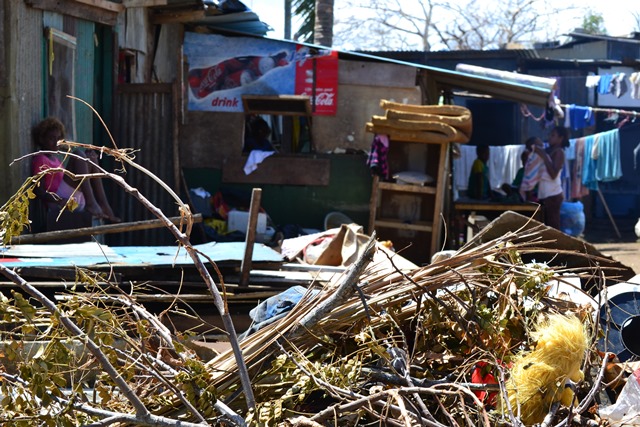Projections indicate 45 villages of the 800 coastal communities affected by the impact of climate change in Fiji will be relocated in the next decade. Sea level rise alone has seen state-managed relocation of coastal communities in the past three years.
For Vunidogoloa villagers on Vanua Levu, the Fiji Government reportedly constructed 30 homes at the new location, complete with fish ponds and farms that reportedly cost $879,000. Fiji has a national climate change policy (2012) which allows it this systematic approach to its response.

For Fiji and other Pacific Island nations, the various manifestations of climate change punctuated by cyclones and hurricanes whose ferocity is expected to get worse will be our reality in the next few years. Our small economy bases and treacherous geographical realities will be tried with an increased level of intensity that we must realistically prepare for.
While we cannot change the impact of the changing climatic systems, we can still share the responsibility of mitigating the expected impact on our lives. The shared responsibility will be most critical when it comes to financing mitigation approaches and humanitarian situations.
The Asia and Pacific neighbourhood is home to more than 80 per cent of the world's disasters and vulnerability to natural disasters are increasing, exacerbated by poverty and environmental destruction. At least 90 per cent of the victims of natural disasters live in developing countries.
While Fiji no longer features in the top 10 countries on the world risk index, Vanuatu, Tonga, Solomon Islands and Papua New Guinea remain on the index considered at the "greatest risk", with Vanuatu claiming the number one spot.
Globally-speaking, women and children are 14 times more likely to die in a disaster. In the Indian Ocean devastating tsunami for example, two out of three deaths were women. Of the more than 80 million people in need of humanitarian assistance in 2014 alone, more than 75 per cent were women and children, majority of who were deeply impoverished.
At any one time, approximately 4 per cent of any displaced or disaster-affected population will be pregnant, out of which 15 per cent will experience pregnancy-related complications. Sixty per cent of maternal deaths and 45 per cent of newborn deaths occur in such "fragile" environments.
It is estimated that 15 per cent of pregnancies in the world will result in complications and some will require emergency obstetric care, for example, a caesarean section. We must never forget as well that also in "normal" times, it is estimated that in the region, one out of two women will have experienced partner or non-partner violence in her lifetime, with some countries reporting prevalence of this behaviour of more than 70 per cent.
When vulnerability to reproductive health-related issues and exposure to violence are at such levels in the best of times, can you imagine how much associated risks are exacerbated when the socioeconomic fabric of communities are crushed into a fragile system, wrought with security issues and threats to people's basic human rights?
Generally speaking, health facilities which are already in dire need for repair are forced to close their doors because of damage from natural disasters, and when these include birthing units, vulnerability to complications and death of both pregnant women and infants are magnified.
When such facilities are shut down, there are implications on family planning supplies and by extension, unplanned pregnancies and exposure to sexually-transmitted infections including HIV. This systematic breakdown also opens us to increased transactional sex.
Post-disaster humanitarian and fragile contexts sometimes lead to formal requests for assistance from countries to the United Nations system. The United Nations Population Fund, UNFPA, works specifically around the issues of reproductive health and gender-based violence.
In its recent work with the Government of Vanuatu and non-government organisations in addressing issues related to the UNFPA mandate areas, in Cyclone Pam-battered communities, UNFPA's intervention covered both reproductive health and gender protection - from technical support to fund-raising efforts, engaging youth and grassroots non-government organisations to the facilitation of midwives to Vanuatu's main referral hospitals.
Considering the magnitude of humanitarian work, we are eventually confronted with the question of where the money is coming from. Apart from traditional donors, the United Nations system also has funding options which the various agencies would have to apply for based on their intervention intention that would have been informed by assessments.
Funding gaps for humanitarian response will be one of the many issues discussed during a regional consultation the UNFPA Pacific Regional Office is supporting in New Zealand at the end of this month. The consultation will subsequently inform the World Humanitarian Summit scheduled later this year, the region's position.
Apart from being gender-sensitive and inclusive of actors, another aspect of UNFPA's support in such situations is ensuring that where appropriate, benefits of interventions are long-term. The public discourse around humanitarian work is also beginning to explore the question of where exactly does humanitarian response end and development aid begin.
Implicit in this consideration is the need to integrate key risk reduction aspects into national development plans. In this way, states that seriously invest in their health sector for example can be sure medical facilities, particularly birthing units, its equipment and its staffing are set up for humanitarian situations.
"If our national development plans are already considerate of the impact natural disasters have on our Pacific Island countries, we would already be institutionalising mitigating factors that will save lives," UNFPA Pacific Sub-Regional Office director and representative Dr Laurent Zessler said.
Whether one speaks of issues arising from a mobile population or the aftermath of a particularly devastating hurricane, reducing risks and thus mitigating their impact are in our hands. We can reverse the enabling environment that perpetuates facts like 60 per cent of maternal deaths and 45 per cent of new-born deaths occur in fragile contexts.



